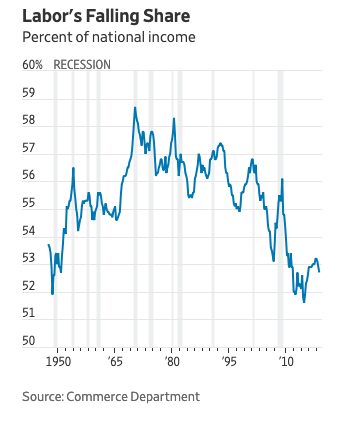Replies
Maybe we should judge labor market tightness by wage growth itself. So we can finally bury the absurd notion of “worker shortages” in a low wage growth environment.
30
113
386
@neelkashkari
I have a new paper where we look to see what has happened to hours of work, multiple job holding, hours of work and self-empt as the unempt rate has fallen from 6%-4% in the UK and USA - would expect to see these both growing and we dont
2
2
4
@neelkashkari
@EconomicPolicy
Of course not.
The visible economy now is unusually full of nil-wage workplaces to an extent far greater than even a decade ago: fast food, restaurants, etc.
Underemployment is sky high; 43% of past five years college grads now are underemployed ("Fortune" Aug. 2018).
0
0
0
@neelkashkari
Have you ever thought about something else is possibly going on? Such as labor market is really not a "free market“, labor has no, or little, bargaining power, etc. etc. For one thing, federal minimum wage in constant dollar is much lower than 70s.
1
0
2
@neelkashkari
@JWMason1
Nah, wages aren't moving up because tech is allowing employers to wrench away any efficiency wage it used to have to pay before it had perfect surveillance of whether workers were shirking. It is a tight labor market too.
1
0
1
@neelkashkari
Exactly
@neelkashkari
. Backing your point is the significant lag in aggregate hours (i.e. work) relative to that of payrolls (i.e. jobs) over the same time.
0
0
2
@neelkashkari
A lot of good points. Corporate America is stronger than ever. Consolidation allows corps to shed workers, lowers competition. Corp America gets a huge tax decrease and instead of wage increase they gave small bonus. The power is in the exec boards, not w the worker
0
1
7
@neelkashkari
There are multiple equilibrium low unemployment rates. There are those with low productivity, below real GDP potential, due to tight money. Then there's that at full capacity.
1
0
1
@neelkashkari
Have to measure labor share correctly to explain trend. This chart looks too negative because of rising share going to depreciation and homeowners' imputed rent. See
1
0
0
@neelkashkari
@hshierholz
Wonder what impact the tax scam's taking away your ability to write off moving expenses is having?????
0
0
0
@neelkashkari
Wage dynamics are a function of many factors; the supply of labor is just one of them. Even with 0% unemployment, it is entirely possible for the wage share to remain low.
0
0
0


















